|
History
Human beings were born with an instinct to fight for survival, especially
self-defence against the most serious danger, that is, “the danger of war”.
Each human race created methods of self-defence both with and without
weapons, varing according to geographical and racial characteristics, until
they became their national art of self-defence and a part of their culture.
In Thailand, the Thai art of self-defence with bare hands is “Muay Thai” and
one of those with weapons is, e.g., Krabi-Krabong. Both of the arts of
fighting have kept Thailand an independent country up until the present day.
The Sukhothai, Ayudhaya, Thonburi and early Rattanakosin (Kings Rama I - IV)
periods of Thailand were all periods of wars against invaders. All men bore
the responsibility to be soldiers. The Thai tradition beleived that being a
fighter was the important characteristic of “brave men”. Not only were the
commoners fighters, but the nation's leaders or kings had also to be brave
fighters. Every type of fighting was considered to be an art for rulers. In
the past, training for the art of Muay Thai and that for Krabi-Krabong would
be carried out together, simultaneously. This was because in real fighting
all sorts of weapons were used, but if the weapons had been dropped or
fighting was at close quarters, the skill of Muay Thai would also be used.
Knowledge of Krabi-Krabong includes the equipment used in fighting, the
skill of dancing, the fight itself and personal skills and talents. The
following are the details:
Grand-Masters
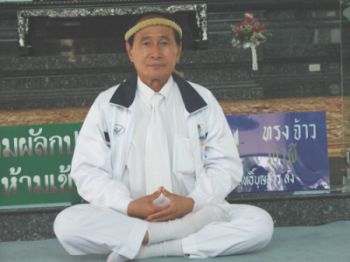
Grand Mater Vichit Cheechurn.
The highest
Master Krabikabong of physical education of Thailand
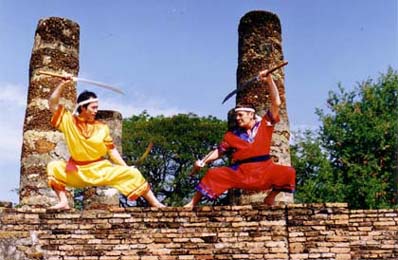
Arjarn Branko Grimsic during the
festival of Sukhothai in 1997
top
Kru Krabi-Krabong
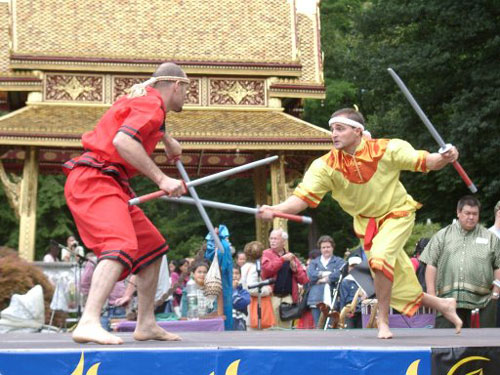
KRU Antonio
Sancillo and his co-trainer Francesco Bonelli from AITMA
training centre Sukhothai/Düsseldorf by the Krabi Krabong presentation
during Thai festival in Bad Homburg/Germany in 2004
Wai-Kru
Krabi-Krabong
One of
Thailand’s special Customs is the 'Wai', it is used on a number of different
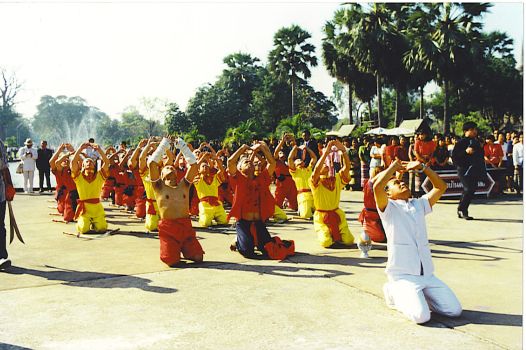
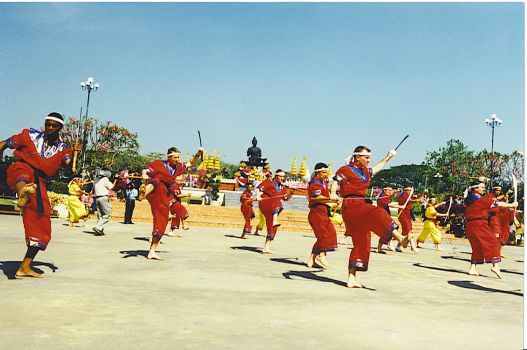
WAI
KRU (Paying homage to the Masters of Krabi-Krabong)
'Kru' is a Thai word which means the person who teaches 'sid',
or passes on knowledge to pupils (sid). Normally Krus are highly respected
in Thai Society. They are knowledge able, full of perseverance. They
practice high moral standards in their way of life, leading very respectable
lives. They always devote themselves to performing their teaching commitment
until their pupils attain full knowledge and are successful in their fields.
Such a Kru is usually rewarded by his sense of achievement, respect from
everyone and an increase in the number of students willing to submit to his
guidance.
To show
sincere appreciation and perseverance, dedication and generosity in
conferring knowledge & providing experience for good opportunities, pupils
in return will submit themselves obediently and respectfully to their own
Teacher's instruction and advice, serve him diligently, and obey the rules
and regulations laid down by him (or her), so that the Teacher can pass on
the knowledge of that particular field to them closely, quickly, properly
and wisely.
Wai Kru is a demonstration of the pupil's respect & gratitude to his teacher
in submission to the teaching & training. Wai Kru is traditionally practised
by Thais of various professions & Arts, e.g dancers, sword fighters,
musicians, as well as academic students, and of course Muay Thai Boxers are
no exception. As we have previously stated, "Wai" means to pay respect by
putting both hands together in front of the chest. The demonstration of Wai
Kru does not only imply paying respect to the present Teacher, but also
includes homage to all the teachers of the discipline.
top
Weapons & Equipment
Equipment
Krabi-Krabong
is the art of fighting with various kinds of weapons; both short and long,
e.g. sword, long knife, long wooden staff, a glaive with curved blade, lance,
short staff, and protective equipment, e.g. shields of various shapes. Each
weapon can be used differently, as follows:
1.
Krabi (long knife): a weapon for slashing and stabbing, made of
good quality iron, flat with a pointed tip, to be used for fighting on
level ground.
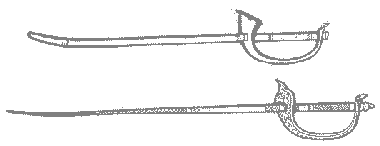
2.
Daab (sword): a weapon for slashing and stabbing, made of good
quality iron, flat with a curved tip, heavier than Krabi, to be used for
fighting on level ground.

3.
Ngaaw (glaive): a long weapon for slashing and stabbing, the
Ngaaw itself is made of good quality iron, flat with a curved tip
similar to that of the daab but shorter in length, with a long wooden
handle, to be used for fighting at a distance from an elephant's back

4.
Plawng (long staff): also called “Si Sawk” (lit., “two yards”)
is a long weapon for striking.

5.
Dahng (shield): a protective device, made of hide or rattan, of
oblong shape, curved in section like the fibrous layers on the trunk of
a banana plant.

6.
Khehn (shield): a protective device, made of hide, of oblong
shape.

7.
Loh (shield): a protective device, made of hide or weaved
rattan, or metal, round in shape, bulging out at the centre.

8.
Mai Sahn (short staff): a square piece of wood shaped to the
bones of the forearm, to be worn on both forearms and used both as a
striking and blocking weapon.
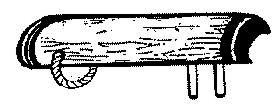
9.
Meed sahn (short knife): a short weapon, shaped like a daab, but
shorter.
10.
Khwaan (axe)
11.
Hawk (arrow)
top
The Thai
arrange the said equipment or weapons into 3 catagories according to their
purpose.
1.
Real weapons : used in fighting and warfare.
2.
Imitation weapons used for performing demonstrations : called
“kreuang mai ram”, they started to be used when Krabi-Krabong was used for
exhibition bouts. Originally, real weapons were used in the exhibition dance
before the fight.
3.
Imitation weapons used for training : called “kreuang mai dtee”,
these imitation weapons are made of rattan, which is a wood easily found in
Thailand, with tough and durable qualities. These weapons are used in
training as, if the real weapons were used, they might wear out, or be
dangerous to the training partner. The use of “kreuang mai dtee” started in
the early Rattanakosin period.
Krabi-Krabong
Skills
The important
skills to be learnt in Krabi-Krabing are those of: skill in weapon
performance and skill in striking (skill in fighting).
The
skill in weapon performance : The following are styles of
performing the weapons from the text of Kru Nak Tebhusadin Na Ayudhaya:
The Krabi
Performance: There are 12 styles in sequence as follows:
1. Loy-chahy
2. Kuang-tahd-hoo 3. Nehb-khaang
4.
Dtahng-sahk 5. Juangnaa-juanglahng 6. Juangbpohkpawng
7. Taa-yahk
8. Sawy-daaw 9. Kuang-dtae
10. Waek-maan
11. Lohd-law 12. Chuhn-tian
The
Performance of two swords: There are 12 styles in sequence as follows:
1. Dtaw-daam
2. Baeg 3. Tahd-hoo
4.
Riang-mawn-sawk 5. Lahd-hua-tian 6. Yahk/Hohng-bpeek-hahk
7.
Sawng-glawng 8. Gaa-gah-baat 9. Fahn-see-daa 10. Sawd-sawy 11. Lohd-law 12.
Um-tian/Tehp-rahmpeung
The Ngaaw
Performance: There are 12 styles in sequence as follows:
1. Tuan-naa
2. Hahk-sawk 3. Paay-reua
4. Dtaw-khaw
5. Sawng-glawng 6. Bpohknaa-bpohklahng
7.
Chaak-pikaat 8. Dtai-raaw-bohn 9. Chaak-chiang
10.
Dtai-raaw-laang 11. Johbjuang 12. Wohng-wian-wibaak
The Plawng
Performance: There are 12 styles in sequence as follows:
1.
Taa-ting-lahng-waad-naa 2. Hahk-sawk 3. Naeb-gaay
4. Dtaw-khaw
5. Sawng-glawng 6. Bpohknaa-bpohklahng
7.
Sahlahb-fahn-bplaa 8. Dtai-raaw-bohn 9. Khahd-lahng
10.
Dtai-raaw-laang 11. Lohd-law 12. Duhn-rahm-pichit- seuk
The
Krabi-Krabong trainees should practice these styles of dancing until they
are so skilful that they can perform them during the Wai Kru before using
them in an actual fight. These styles of dancing, which are equivalent to
the “warm up” for international sports before the actual games, were known
to the Thais from long ago. The Thais have suitably added the beauty of
dance, accompanied by music, to the exercise of bodily strength.
top
The
skill in striking : In Krabi-Krabong, the fighting skill is called
the skill in striking, which includes the main techniques of striking and
the fighters' own personal styles of modified techniques.
The
main techniques of striking : consist of strikes for attacking and
defending. Both techniques contain fixed procedures for attacking and
defending which the trainees have to practice until they are proficient.
These techniques show the importance of various parts of the body.
The
modified techniques of striking : are techniques used in real
fighting which have to be modified according to the circumstances and cannot
be fixed.
Patterns and procedure in performing Krabi-Krabong :
In performing
Krabi-Krabong, the following stages of training should be followed:
1.
Paying obeisance : In ancient times, when the king used to preside
at training sessions or competitions, the paying of obeisance was done to
the king. In addition, the ancient Thais had a high respect for the king,
therefore even when the king was not there, the fighters still paid
obeisance to the king. This performance, besides being for the king, also
pays homage to the triple gems in Buddhism, parents, and teachers who passed
knowledge on to them, and also includes the recitation of the sacred chants
to increase their mental power for fighting their opponent.
2. Kheun
Brahman Styles : These are the important principal styles
to be taught. There are two kinds of Kheun Brahman: Seated Brahman and
Standing Brahman. The Kheun Brahman style is a dance moving in four
directions, which is why it is called Brahman, as the god Brahma has four
faces. The name also comes from the four qualities of Brahma, vtz., Mettra,
Karuna, Muttita and Ubekha, which are the qualities that the teacher will
impart to his pupils.
3.
The dance of the fighting techniques : The techniques performed
depend on the weapons used in fighting, any fixed techniques chosen for
performance are acceptable.
4.
The Walking around : A type of walk in readiness to fight. This
walk will cover the whole distance to the edge of the groud and return to
the starting point. Whilst at close quarters to the opponent, each
competitor will move somewhat to the left, so that only the tips of the
weapons may touch or hit each other slightly.
5.
The fighting : The attacking and defending techniques learnt and
the personal aptitude in fighting will be used.
6.
The asking for pardon : When the fight ends, both competitors will
ask their opponents to pardon any unintentional wrongdoing during the fight.
This forgiveness is an important quality that the teachers must impart to
their pupils.
Music
accompanying the demonstration of Krabi-Krabong
Krabi-krabong
demonstrations will be accompanied by the music of Javan flute and Indian
drum. The music performance is divided in phases as follows:
1.
Played before the fight , in the Wai Kru ceremony.
2.
Played as a stimulating intermission , after the Wai Kru ceremony.
3.
Played during the fights .
The music
will be appropriate to the weapons. For example, Krabi-Krabong will use
Krabileela music; Ngaaw, Kheun maa. Nowadays, it is rare to find experts
capable of playing the specific music for any weapon, so there has been
adaptation of the music and the use of one kind of music for all weapons.
The use of
musical equipment in the demonstrations derives from the Thai characteristic
love of joyfulness. Whatever activity they undertake, there will always be
musical accopaniment. Besides arousing enjoyment in the fighters and the
audience, it provides the correct rythm for dancing. The use of music to
accompany the fighting started in the Ayudhaya period and is still used
today.
The
Dress
The dress
used in Krabi-Krabong demonstrations is the same as that worn by ancient
Thai warriors; a tunic, sleevelesss or with long sleeves, with sacred
inscriptions, and wide-legged mid-calf-length trousers.
In addition,
the demonstrator will wear a Monkon which is made of sacred cotton thread.
In ancient time, the Monkon would be worn all the time even during the
fight, as the Monkon is a sacred charm which the pupil received from his
teacher, and will provide him with confidence in fighting to win as well as
to safeguard him from dangers.
The
Study of Krabi-Krabong
When a Thai
studies Krabi-Krabong, the important thing he has to do is to submit as a
pupil or to accept the Master as one's teacher showing that one willingly
obeys to be taught, trained, and have one's characteristics moulded by the
teacher. The teacher in return accepts that person as his pupil, is happy to
pass his knowledge willingly on to him as if he was his son or other
descendant. In olden days, acceptance as a pupil was not done easily. The
pupil who sought knowledge would have to serve at the teacher's home so that
the teacher would be able to observe whether the pupil had paid attention to
study, and had patience, attained good qualities satisfactorily and was
trustworthy, before the teacher would perform the pupil acceptance ceremony.
Kru Nak
Tebhusadin Na Ayudhaya outlined the practice of Wai Kru and the submission
as a pupil as follows:
1.
The religious ceremony
2.
The ceremony of submission as a pupil
2.1
Offerrings to the teacher.
2.2 The pupil
must prepare five white flowers, incense sticks, one white candle and money
to pay homage to the teacher.
2.3 The
master of ceremonies will prepare the sacred water and paste for anointing
the pupil's forehead.
2.4 A group
of ceremonial performers will lead by pronouncing the words of submission
and the oath.
2.5 Sitting
still thinking of teachers and feeling loving kindness.
2.6 In
accepting any student, the teacher will receive the flowers, incense sticks
and candle, and anoint the pupil‘s forehead, whilst the pupil will drink the
sacred water, and put the candle wax on his head.
Afterwards
there will be a demonstration of the pupil's skills, then a feast. The Wai
Kru ceremony will be performed every year and also each time before a
demonstration, but not as a big ceremony, only using flowers and incense
sticks as offerrings.
Krabi-Krabong
is the Thai national art of fighting with personal characteristics. The
teacher will emphasise the teaching of “the person” (the pupil) to be good
before he teaches the skills of fighting, so that the pupil will use the
knowledge gairned in the proper way which will not be harmful to society.
The study of Krabi-Krabong is not only the study of the skills of fighting,
the pupil must have good understanding and study Thai ways of thougth and
belief which are disquised in various forms and symbols of the Krabi-Krabong
sport. Such thougths and beliefs have moulded the Thais into specific
characteristics such as the respect for seniority, gratitude towards
teachers, politeness, cheerfulness, belief in the importance of mind in
controlling the body, and so on. After having studied the abstract and
concrete values of Krabi-Krabong, one will be considered to have real
knowledge of the Thai Krabi-Krabong.
*********
Compiled by
Suchitra Sukontasap Translated by Associate Professor
Physical
Education Department, Parnsri Wichagonrakul and
Faculty of
Education, Chulalongkorn University. Paul L Sowerby.
top
|